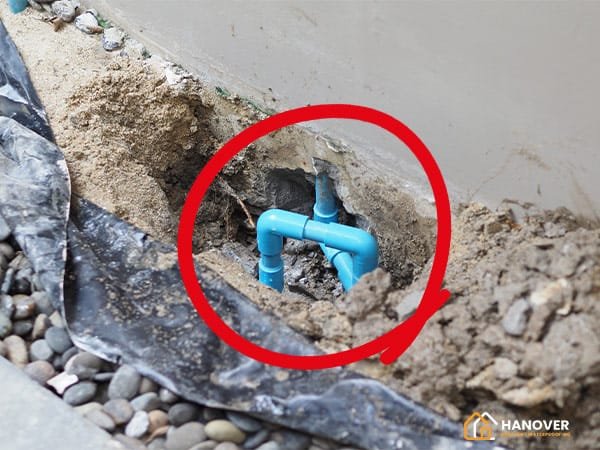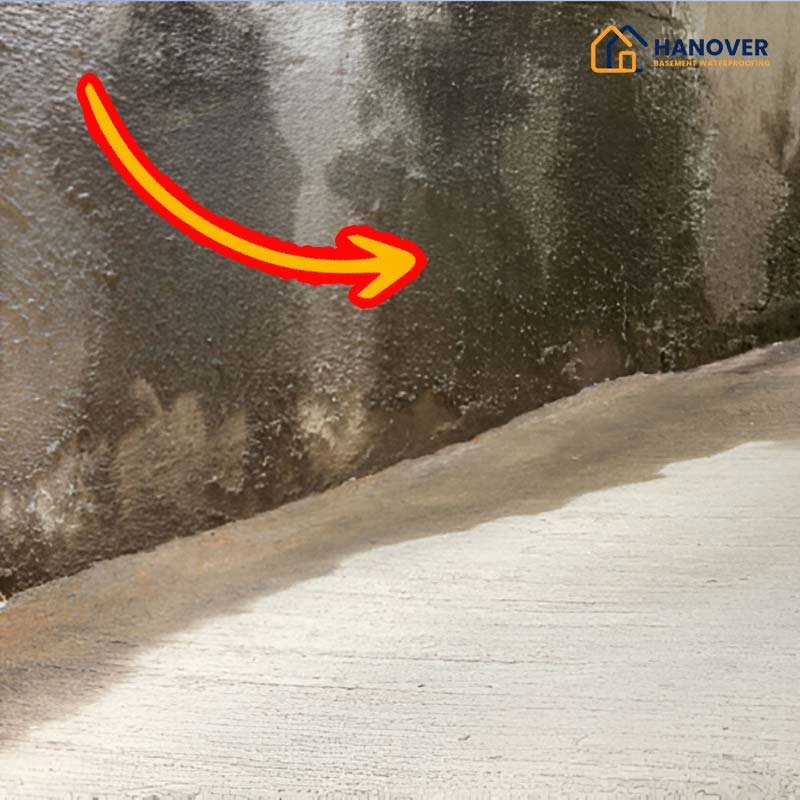1. Proper Grading and Exterior Drainage Management
Improper yard grading is one of the leading causes of basement water seepage. When the soil around a home’s foundation slopes toward the building, it encourages surface water runoff to pool against basement walls. Over time, this leads to hydrostatic pressure that forces moisture through cracks and joints in the foundation.
To prevent this, the ground must be graded away from the home, with a minimum slope of six inches over ten feet. Use compact fill dirt followed by topsoil to rebuild the slope and maintain it seasonally. Avoid using mulch or landscaping material directly against foundation walls, as these often retain moisture.
Additionally, installing swales, French drains, or gravel trenches can redirect excess water away from the structure. These systems should terminate at a safe discharge point such as a storm sewer or a dry well. The USDA NRCS Drainage Handbook provides further standards for exterior grading in residential areas.

2. Install and Maintain a Functional Gutter and Downspout System
Many homeowners overlook the impact of an underperforming gutter system. When gutters are clogged, undersized, or poorly pitched, they overflow, dumping water directly next to foundation walls. Over time, this water seeps downward and infiltrates the basement.
To prevent this, every home should be equipped with:
- Seamless aluminum gutters sized according to local rainfall.
- Gutter guards to reduce leaf and debris accumulation.
- Downspouts that extend at least 6 to 10 feet away from the home.
For maximum effectiveness, downspout extensions should connect to solid PVC drain pipes that lead water to a safe discharge zone, such as a retention pond or curb cut. Annual gutter cleanings in spring and fall are essential, particularly in areas with overhanging trees.
Verify compliance with regional rainfall patterns using EPA Rainfall Data.
3. Waterproof the Foundation Walls
Exterior foundation waterproofing is a long-term solution that involves applying a liquid rubber membrane or polymer-modified asphalt to the outer foundation wall surfaces. These coatings form a continuous, impermeable layer that prevents moisture from penetrating into the basement.
Installation typically requires excavating the soil around the foundation to full depth, cleaning the walls, patching cracks, and applying multiple coats of waterproofing material. For added protection, contractors often install:
- Dimpled drain boards
- Geotextile fabrics
- Perforated footing drains
These elements work in combination to create a moisture-resilient barrier. For older homes, consider internal sealants like silicate-based penetrating sealers, but these are supplementary and should not replace external solutions.
A good technical primer is offered by the International Association of Certified Home Inspectors. Learn how our Hanover basement waterproofing services apply advanced exterior sealing and drainage to block water at the source.
4. Install a Sump Pump with a Redundant Backup System
Sump pump installation is one of the most effective mechanical methods for removing water that accumulates beneath a home. This system works by channeling water through an interior perimeter drain system into a sump basin, where a submersible pump then ejects it away from the structure.
Key features of a reliable system include:
- A high-capacity sump basin (minimum 18″ diameter, 24″ depth).
- A 1/2 horsepower cast iron sump pump with a vertical float switch.
- PVC discharge piping with a check valve to prevent backflow.
To ensure continued operation during power outages, install a battery backup sump pump or a water-powered backup system. In areas like Hanover, PA where heavy rains often coincide with power failures, this redundancy prevents flooding when it’s most likely to occur.
Consider models tested by Consumer Reports or those that meet Plumbing Manufacturers International standards for safety and capacity.
Routine maintenance includes cleaning the pit, testing the float switch quarterly, and inspecting the discharge line for obstructions or freezing. We install sump pump systems in Hanover with battery backups to prevent water damage during heavy storms and outages.
5. Implement an Interior Drainage System (French Drain Alternative)
When external excavation isn’t possible or cost-effective, an interior drainage system provides a practical solution. This involves cutting a trench along the basement perimeter, laying perforated piping into gravel, and connecting it to a sump pump system.
Unlike traditional French drains which are installed outside, this system redirects water that leaks through walls or under the slab into a controlled drainage path. It’s often paired with:
- Cement repair of the floor slab
- Drain tile inspection ports
- Heavy-duty channel liners
Interior systems are less disruptive, cost-effective, and work well for homes with high water tables or limited access to external soil. They are compliant with local building codes and can usually be installed in one or two days.
Verify technical specifications through the Basement Health Association.
Bonus Method: Use Vapor Barriers and Dehumidification for Moisture Control
Moisture barriers and dehumidification are not primary seepage prevention tools but play a vital role in creating a dry basement environment. They combat ambient humidity, capillary rise, and airborne moisture.
Install 6-mil polyethylene vapor barriers behind finished walls and under flooring. In crawlspaces, use reinforced vapor liners sealed to walls and piers. Add a basement-rated dehumidifier with:
- Auto-drain function
- Built-in hygrometer
- Coverage up to 2,500 sq ft
These tools lower relative humidity below 50%, reducing mold risk and musty odors. For energy-efficient performance, consult Energy Star certified models. See our picks for the best dehumidifiers for basements and crawl spaces to control humidity and protect your home’s air quality.
Inspection and Maintenance Checklist for Long-Term Water Protection
Even the best basement water control systems require regular inspection to remain effective. Use this checklist to stay ahead of moisture intrusion:
- Check grading slopes annually in early spring. Soil compaction over winter can reverse slopes.
- Inspect gutter systems for clogs and misaligned sections every 6 months.
- Flush downspouts and verify that extensions are secure and angled properly.
- Test sump pump systems before every heavy rain season by lifting the float manually.
- Scan basement walls for signs of efflorescence (white mineral deposits), which indicate water is entering behind the surface.
- Use a hygrometer to monitor humidity levels, especially after long rainy spells.
Timely inspection ensures that early signs of failure—such as pump cycling irregularities or downspout pooling—are addressed before major water ingress occurs.
Signs That Your Waterproofing System is Failing
Even with protections in place, several red flags indicate that your waterproofing strategy may need repair or upgrade:
- Persistent damp patches along the base of walls.
- Rust formation around wall anchors or metal pipes.
- Unusual sump pump noise or continuous cycling.
- Musty odors despite using a dehumidifier.
- Cracks widening or appearing around corners and floor-wall joints.
- Standing water near downspout exits or entry door thresholds.
These issues often suggest blocked perimeter drains, an overwhelmed sump system, or foundation settlement causing new entry points. Prompt evaluation by a certified basement waterproofing contractor is critical.
For Hanover-area inspections, consult local licensed experts listed in the Pennsylvania Department of Labor & Industry database.
Local Considerations for Hanover, PA Homeowners
Homes in Hanover, PA face unique challenges due to:
- High clay content soils, which expand with moisture and contract when dry.
- Frequent freeze-thaw cycles from October to April, which strain foundation joints.
- Occasional flash floods, particularly in low-lying zones east of town center.
Due to these conditions:
- Always use reinforced vapor barriers in finished basements.
- Consider external footing drains paired with internal solutions for maximum control.
- Ensure local compliance with stormwater runoff codes managed by York County Planning Commission.
Additionally, many homes in the region have cinder block foundations, which are more porous than poured concrete. These require enhanced surface sealing and careful crack monitoring.
Check with Hanover Borough Building Department for permits and approved contractors.
Final Thoughts
To fully prevent water from seeping into your basement:
- Combine external grading and drainage with internal mechanical systems.
- Reinforce these with vapor barriers and humidity control.
- Monitor, maintain, and adapt your strategy based on local soil behavior and seasonal patterns.
A proactive, layered approach ensures peace of mind—and a dry basement—year-round.
FAQs
1. How do I know if water is seeping into my basement?
Signs of water seepage include damp walls, musty odours, visible mould or mildew, and puddles on the floor after heavy rain. If you notice these, it’s time to address potential water issues.
2. Can I prevent water seepage without professional help?
Yes, many methods, like grading your landscaping, cleaning gutters, and sealing cracks, can be done independently. However, if the problem persists or is more severe, consulting a professional may be necessary.
3. How often should I clean my gutters and downspouts?
It’s recommended to clean your gutters at least twice a year, more frequently if you have trees near your home. Blocked gutters can lead to water overflowing and pooling near your foundation.
4. Will installing a sump pump completely solve my basement water problems?
While a sump pump effectively pumps out water, it’s best combined with other preventative measures, like proper grading and sealing cracks. A sump pump alone may not address the underlying causes of seepage.
5. How can I tell if my basement has mould or mildew?
Mould and mildew often appear as dark spots on walls or floors, producing a musty odour. If you spot these signs, addressing the water issue causing the moisture is essential.
6. What is the best way to seal foundation cracks?
Use a high-quality, waterproof sealant designed for foundation cracks. If the cracks are large or there’s significant structural damage, consider hiring a professional to assess and repair the issue.
7. How can exterior drainage systems help prevent basement water problems?
Exterior drainage systems, like French and footing drains, direct water away from the foundation, reducing the pressure and potential for seepage. These solutions are effective in preventing long-term water issues.
8. How do I maintain my sump pump?
Test your sump pump periodically by pouring water into the pit to ensure it activates properly. Check for any pump or discharge pipe blockages and clear them as needed. Consider a battery backup for extra protection during power outages.


